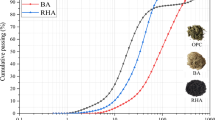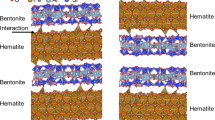Abstract
Cemented paste backfill (CPB) is one of the effective methods for resource utilization of tailings, but the high cost of ordinary Portland cement (OPC) limits its utilization. Considering the poor performance of Na2CO3-activated binders, in this work, supplementary materials, including CaO, MgO, and calcined layered double hydroxide (CLDH), were used to modify their properties with the aim of finding an alternative binder to OPC. Isothermal calorimetry, X-ray diffraction, and thermogravimetric analyses were conducted to explore the reaction kinetics and phase assembles of the binder. The properties of the CPB samples, such as flowability, strength development, and heavy metal immobilization effects, were then investigated. The results show that the coupling utilization of MgO and CLDH showed good performance. The strength of the Mg2-CLDH3 sample was approximately 2.94 MPa after curing for 56 d, which was higher than that of the OPC-based sample. Moreover, the cost of the modified Na2CO3-activated binder was lower than that of the OPC-based binder. Modified sample showed satisfactory heavy metal immobilization effects. These findings demonstrate that carbonate-activated binder modified by supplementary materials can be suitable in CPB.
Similar content being viewed by others
References
D.L. Shang, G.Z. Yin, X.S. Li, et al., Analysis for green mine (phosphate) performance of China: An evaluation index system, Resour. Policy, 46(2015), p. 71.
I.M. Jiskani, Q.X. Cai, W. Zhou, and S.A. Ali Shah, Green and climate-smart mining: A framework to analyze open-pit mines for cleaner mineral production, Resour. Policy, 71(2021), art. No. 102007.
S.Q. Zhang, T.Y. Shi, W. Ni, et al., The mechanism of hydrating and solidifying green mine fill materials using circulating fluidized bed fly ash-slag-based agent, J. Hazard. Mater., 415(2021), art. No. 125625.
H.Q. Shi, Mine green mining, Energy Procedia, 16(2012), p. 409.
Z.G. Fu and H.C. Liao, Unbalanced double hierarchy linguistic term set: The TOPSIS method for multi-expert qualitative decision making involving green mine selection, Inf. Fusion, 51(2019), p. 271.
S.Y. Zhang, F.Y. Ren, Y.L. Zhao, J.P. Qiu, and Z.B. Guo, The effect of stone waste on the properties of cemented paste backfill using alkali-activated slag as binder, Constr. Build. Mater., 283(2021), art. No. 122686.
S.Y. Zhang, Y.L. Zhao, H.X. Ding, J.P. Qiu, and C. Hou, Effect of sodium chloride concentration and pre-curing time on the properties of cemented paste backfill in a sub-zero environment, J. Cleaner Prod., 283(2021), art. No. 125310.
S.Y. Zhang, Y.L. Zhao, H.X. Ding, J.P. Qiu, and Z.B. Guo, Recycling flue gas desulfurisation gypsum and phosphogypsum for cemented paste backfill and its acid resistance, Constr. Build. Mater., 275(2021), art. No. 122170.
Y.L. Zhao, J.P. Qiu, P.Q. Wu, Z.B. Guo, S.Y. Zhang, and X.G. Sun, Preparing a binder for cemented paste backfill using low-aluminum slag and hazardous oil shale residue and the heavy metals immobilization effects, Powder Technol., 399(2022), art. No. 117167.
Y.L. Zhao, J.P. Qiu, S.Y. Zhang, et al., Recycling of arsenic-containing biohydrometallurgy waste to produce a binder for cemented paste backfill: Mix proportion optimization, Powder Technol., 398(2022), art. No. 117155.
Y. Zhao, A. Soltani, A. Taheri, M. Karakus, and A. Deng, Application of slag–cement and fly ash for strength development in cemented paste backfills, Minerals, 9(2018), No. 1, art. No. 22.
Y. Zhao, A. Taheri, A. Soltani, M. Karakus, and A. Deng, Strength development and strain localization behavior of cemented paste backfills using Portland cement and fly ash, Materials, 12(2019), No. 20, art. No. 3282.
Á. Fernández, J.L. García Calvo, and M.C. Alonso, Ordinary Portland Cement composition for the optimization of the synergies of supplementary cementitious materials of ternary binders in hydration processes, Cem. Concr. Compos., 89(2018), p. 238.
S. Naganathan, H.A. Razak, and S.N.A. Hamid, Properties of controlled low-strength material made using industrial waste incineration bottom ash and quarry dust, Mater. Des., 33(2012), p. 56.
F. Cihangir, B. Ercikdi, A. Kesimal, A. Turan, and H. Deveci, Utilisation of alkali-activated blast furnace slag in paste backfill of high-sulphide mill tailings: Effect of binder type and dosage, Miner. Eng., 30(2012), p. 33.
H.Q. Jiang, Z.J. Qi, E. Yilmaz, J. Han, J.P. Qiu, and C.L. Dong, Effectiveness of alkali-activated slag as alternative binder on workability and early age compressive strength of cemented paste backfills, Constr. Build. Mater., 218(2019), p. 689.
S.H. Kang, Y.H. Kwon, S.G. Hong, S. Chun, and J. Moon, Hydrated lime activation on byproducts for eco-friendly production of structural mortars, J. Clean. Prod., 231(2019), p. 1389.
C.J. Shi and R.L. Day, Pozzolanic reaction in the presence of chemical activators, Cem. Concr. Res., 30(2000), No. 1, p. 51.
D. Jeon, W.S. Yum, Y. Jeong, and J.E. Oh, Properties of quick-lime(CaO)-activated Class F fly ash with the use of CaCl2, Cem. Concr. Res., 111(2018), p. 147.
J.X. Wang, X.J. Lyu, L.Y. Wang, X.Q. Cao, Q. Liu, and H.Y. Zang, Influence of the combination of calcium oxide and sodium carbonate on the hydration reactivity of alkali-activated slag binders, J. Cleaner Prod., 171(2018), p. 622.
Y.L. Zhao, J.P. Qiu, S.Y. Zhang, et al., Effect of sodium sulfate on the hydration and mechanical properties of lime-slag based eco-friendly binders, Constr. Build. Mater., 250(2020), art. No. 118603.
H.Q. Jiang, M. Fall, E. Yilmaz, Y.H. Li, and L. Yang, Effect of mineral admixtures on flow properties of fresh cemented paste backfill: Assessment of time dependency and thixotropy, Powder Technol., 372(2020), p. 258.
X. Chen, A. Meawad, and L.J. Struble, Method to stop geopolymer reaction, J. Am. Ceram. Soc., 97(2014), No. 10, p. 3270.
C09 Committee, Test Method for Compressive Strength of Cylindrical Concrete Specimens, ASTM International, West Conshohocken, PA, 2021.
Y.L. Zhao, X.W. Gu, J.P. Qiu, S.Y. Zhang, Z.B. Guo, and X.G. Sun, Recycling of arsenic-containing biohydrometallurgy waste to produce a binder for cemented paste backfill: Co-treatment with oil shale residue, J. Environ. Manage., 319(2022), art. No. 115621.
Karen Scrivener, A Practical Guide to Microstructural Analysis of Cementitious Materials, Taylor & Francis Group, London, 2016.
X.Y. Ke, S.A. Bernal, and J.L. Provis, Controlling the reaction kinetics of sodium carbonate-activated slag cements using calcined layered double hydroxides, Cem. Concr. Res., 81(2016), p. 24.
N.T. Dung, T.J.N. Hooper, and C. Unluer, Accelerating the reaction kinetics and improving the performance of Na2CO3-activated GGBS mixes, Cem. Concr. Res., 126(2019), art. No. 105927.
J.W. Bullard, H.M. Jennings, R.A. Livingston, et al., Mechanisms of cement hydration, Cem. Concr. Res., 41(2011), No. 12, p. 1208.
B. Yuan, Q.L. Yu, and H.J.H. Brouwers, Time-dependent characterization of Na2CO3 activated slag, Cem. Concr. Compos., 84(2017), p. 188.
D. Jeon, Y.B. Jun, Y. Jeong, and J.E. Oh, Microstructural and strength improvements through the use of Na2CO3 in a cementless Ca(OH)2-activated Class F fly ash system, Cem. Concr. Res., 67(2015), p. 215.
S.A. Bernal, J.L. Provis, R.J. Myers, R. San Nicolas, and J.S.J. van Deventer, Role of carbonates in the chemical evolution of sodium carbonate-activated slag binders, Mater. Struct., 48(2015), No. 3, p. 517.
A. Fernández-Jiménez and F. Puertas, Setting of alkali-activated slag cement. Influence of activator nature, Adv. Cem. Res., 13(2001), No. 3, p. 115.
J.L. Bischoff, D.B. Herbst, and R.J. Rosenbauer, Gaylussite formation at mono lake, California, Geochim. Cosmochim. Acta, 55(1991), No. 6, p. 1743.
J. Xin, L. Liu, L.H. Xu, J.Y. Wang, P. Yang, and H.S. Qu, A preliminary study of aeolian sand-cement-modified gasification slag-paste backfill: Fluidity, microstructure, and leaching risks, Sci. Total. Environ., 830(2022), art. No. 154766.
Y. Sun, Y.L. Zhao, J.P. Qiu, S.Y. Zhang, X.G. Sun, and X.W. Gu, Preparation and characterization of a new alkali-activated binder for superfine-tailings mine backfill, Environ. Sci. Pollut. Res. Int., 29(2022), No. 48, p. 73115.
R.J. Myers, E. L’Hôpital, J.L. Provis, and B. Lothenbach, Effect of temperature and aluminium on calcium (alumino)silicate hydrate chemistry under equilibrium conditions, Cem. Concr. Res., 68(2015), p. 83.
A.M. Chaka and A.R. Felmy, Ab initio thermodynamic model for magnesium carbonates and hydrates, J. Phys. Chem. A, 118(2014), No. 35, p. 7469.
Y.L. Zhao, P.Q. Wu, J.P. Qiu, et al., Recycling hazardous steel slag after thermal treatment to produce a binder for cemented paste backfill, Powder Technol., 395(2022), p. 652.
Y. He, Q.S. Chen, C.C. Qi, Q.L. Zhang, and C.C. Xiao, Lithium slag and fly ash-based binder for cemented fine tailings backfill, J. Environ. Manage., 248(2019), art. No. 109282.
Q.S. Chen, Q.L. Zhang, A. Fourie, and C. Xin, Utilization of phosphogypsum and phosphate tailings for cemented paste backfill, J. Environ. Manage., 201(2017), p. 19.
W. Chen, Y. Li, P.L. Shen, and Z.H. Shui, Microstructural development of hydrating Portland cement paste at early ages investigated with non-destructive methods and numerical simulation, J. Nondestruct. Eval., 32(2013), No. 3, p. 228.
D. Lootens, P. Jousset, L. Martinie, N. Roussel, and R.J. Flatt, Yield stress during setting of cement pastes from penetration tests, Cem. Concr. Res., 39(2009), No. 5, p. 401.
D.P. Bentz, E.J. Garboczi, C.J. Haecker, and O.M. Jensen, Effects of cement particle size distribution on performance properties of Portland cement-based materials, Cem. Concr. Res., 29(1999), No. 10, p. 1663.
T. Sato and J.J. Beaudoin, Effect of nano-CaCO3 on hydration of cement containing supplementary cementitious materials, Adv. Cem. Res., 23(2011), No. 1, p. 33.
W.S. Yum, Y. Jeong, H. Song, and J.E. Oh, Recycling of limestone fines using Ca(OH)2- and Ba(OH)2-activated slag systems for eco-friendly concrete brick production, Constr. Build. Mater., 185(2018), p. 275.
Y.Y. Wu, P. Duan, and C.J. Yan, Role of layered double hydroxides in setting, hydration degree, microstructure and compressive strength of cement paste, Appl. Clay Sci., 158(2018), p. 123.
B. Guo, B. Liu, J. Yang, and S.G. Zhang, The mechanisms of heavy metal immobilization by cementitious material treatments and thermal treatments: A review, J. Environ. Manage., 193(2017), p. 410.
S.Y. Zhang, Y.L. Zhao, Z.B. Guo, and H.X. Ding, Stabilization/solidification of hexavalent chromium containing tailings using low-carbon binders for cemented paste backfill, J. Environ. Chem. Eng., 9(2021), No. 1, art. No. 104738.
S. Fan, B. Cao, N. Deng, Y.D. Hu, and M. Li, Effects of ferrihydrite nanoparticle incorporation in cementitious materials on radioactive waste immobilization, J. Hazard. Mater., 379(2019), art. No. 120570.
F.L. Long, C.G. Niu, N. Tang, et al., Highly efficient removal of hexavalent chromium from aqueous solution by calcined Mg/Al-layered double hydroxides/polyaniline composites, Chem. Eng. J., 404(2021), art. No. 127084.
S.P. Chen, X.Y. Sun, X. Luo, and Z.W. Liang, CO2 adsorption on premodified Li/Al hydrotalcite impregnated with polyethylenimine, Ind. Eng. Chem. Res., 58(2019), No. 3, p. 1177.
M. Daud, A. Hai, F. Banat, et al., A review on the recent advances, challenges and future aspect of layered double hydroxides (LDH) - Containing hybrids as promising adsorbents for dyes removal, J. Mol. Liq., 288(2019), art. No. 110989.
Z.Q. Sun and A. Vollpracht, Leaching of monolithic geopolymer mortars, Cem. Concr. Res., 136(2020), art. No. 106161.
W.J. Long, T.H. Ye, F. Xing, and K.H. Khayat, Decalcification effect on stabilization/solidification performance of Pb-containing geopolymers, Cem. Concr. Compos., 114(2020), art. No. 103803.
Acknowledgements
This work was financially supported by the Key Laboratory of the Ministry of Education on Safe Mining of Deep Metal Mines, Northeastern University (No. 2017SMDM-KF-A01) and the Fundamental Research Funds for the Central Universities (No. N2101043).
Author information
Authors and Affiliations
Corresponding author
Additional information
Conflict of Interest
Haiqiang Jiang is a youth editorial board member for this journal and was not involved in the editorial review or the decision to publish this article. The authors have no relevant financial or non-financial interests to disclose.
Supplementary Information
12613_2022_2540_MOESM1_ESM.docx
Carbonate-activated binder modified by supplementary materials for mine backfill and the associated heavy metal immobilization effects, approximately 224 KB.
Rights and permissions
About this article
Cite this article
Dai, X., Gu, X., Zheng, J. et al. Carbonate-activated binder modified by supplementary materials for mine backfill and the associated heavy metal immobilization effects. Int J Miner Metall Mater 30, 1548–1559 (2023). https://doi.org/10.1007/s12613-022-2540-2
Received:
Revised:
Accepted:
Published:
Issue Date:
DOI: https://doi.org/10.1007/s12613-022-2540-2




